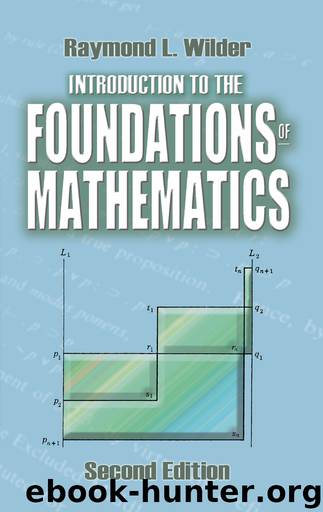Introduction to the Foundations of Mathematics by Raymond L. Wilder

Author:Raymond L. Wilder
Language: eng
Format: epub
Publisher: Dover Publications, Inc.
Published: 1952-06-26T16:00:00+00:00
1.4.2 Consistency of the axiom system Λ
Is it possible to show the axiom system Λ consistent? Here is a case where we cannot, for a model, exhibit any finite collection of physical objects, such as we did for the system Γ of I 2.2. As a matter of fact, for our consistency proof we resort to the concept which underlies the axioms (see I 5, II 6)! The collection R+ and < defined as in 1.1 form a model of the system A. (Cf. Problem 8.)
1.4.3 Independence of the axioms of Λ
The following interpretations, together with the system (R, <), show the independence of the axioms of Λ (cf. II 3, Definition 3.1.1).
1.4.3.1 Interpretation of [Λ – (1)] + ∼(1). Let M1 be an ordered set defined as follows: The elements of M1 are the points in the coordinate plane of the sets , & (x = y)}, S3 = {(x, y)|(x > 0) & (x = – y)} Definition of < : For p, q ε Si, i = 1, 2, 3, where p = (x1, y1), q = (x2, y2), p < q means x1 < x2. For all p ε S1, q ε Si, i = 2, 3, p < q. For p ε S2, q ε S3, there is no < relation. For M1, axiom (1) fails, axioms (2) to (4) are satisfied.
1.4.3.2 Interpretation of [Λ – (2)] + ∼(2). Let M2 consist of the elements of F with < defined as in 1.1.
1.4.3.3 Interpretation of [Λ – (3)] + ∼(3). Let M3 be the set S and relation < of 1.2.6.1, with the points (0, 0) and (1, 1) deleted. Or let M3 be the set Γ and relation < of 1.2.6.2, with the first element of Γ deleted. (Cf. Problems 9 and 10.)
These interpretations also show, incidentally, that the assumption of density (1.2.2.1) alone in axiom (3) would not have been sufficient to characterize the order type of R. (The integers in their usual order suffice as a model of [Λ − (3)] + ∼(3), but they do not have the density property.) For both S and Γ have the density property, yet neither is of the same order type as R, nor is either of the same order type as the other (cf. Problem 6).† The “lines” S and Γ are “too long” to put in euclidean spaces (to “straighten out” S, imagine that the position of S in the plane is the result of a folding process, accordion fashion, and perform the unfolding process on it).
1.4.3.4 Interpretation of [Λ – (4)] + ∼(4). Let M4 be any one of the following ordered subsets of .
1.4.3.5 Remark. It is of some interest to observe that the system Λ – (4) has only four possible types of interpretations. That is, with isomorphism with respect to Λ – (4) as an equivalence relation ≈ in the set K of all interpretations of Λ – (4), there are exactly four classes in the class decomposition of K corresponding to ≈ (II 8.
Download
This site does not store any files on its server. We only index and link to content provided by other sites. Please contact the content providers to delete copyright contents if any and email us, we'll remove relevant links or contents immediately.
| Applied | Geometry & Topology |
| History | Infinity |
| Mathematical Analysis | Matrices |
| Number Systems | Popular & Elementary |
| Pure Mathematics | Reference |
| Research | Study & Teaching |
| Transformations | Trigonometry |
Modelling of Convective Heat and Mass Transfer in Rotating Flows by Igor V. Shevchuk(6406)
Weapons of Math Destruction by Cathy O'Neil(6215)
Factfulness: Ten Reasons We're Wrong About the World – and Why Things Are Better Than You Think by Hans Rosling(4713)
A Mind For Numbers: How to Excel at Math and Science (Even If You Flunked Algebra) by Barbara Oakley(3256)
Descartes' Error by Antonio Damasio(3248)
Factfulness_Ten Reasons We're Wrong About the World_and Why Things Are Better Than You Think by Hans Rosling(3216)
TCP IP by Todd Lammle(3155)
Fooled by Randomness: The Hidden Role of Chance in Life and in the Markets by Nassim Nicholas Taleb(3080)
Applied Predictive Modeling by Max Kuhn & Kjell Johnson(3041)
The Tyranny of Metrics by Jerry Z. Muller(3028)
The Book of Numbers by Peter Bentley(2931)
The Great Unknown by Marcus du Sautoy(2662)
Once Upon an Algorithm by Martin Erwig(2622)
Easy Algebra Step-by-Step by Sandra Luna McCune(2604)
Lady Luck by Kristen Ashley(2554)
Police Exams Prep 2018-2019 by Kaplan Test Prep(2516)
Practical Guide To Principal Component Methods in R (Multivariate Analysis Book 2) by Alboukadel Kassambara(2513)
All Things Reconsidered by Bill Thompson III(2371)
Linear Time-Invariant Systems, Behaviors and Modules by Ulrich Oberst & Martin Scheicher & Ingrid Scheicher(2346)
